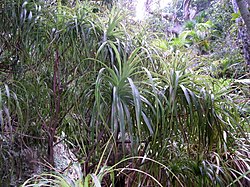| Dracophyllum fitzgeraldii | |
|---|---|
 | |
| Scientific classification | |
| Kingdom: | Plantae |
| Clade: | Tracheophytes |
| Clade: | Angiosperms |
| Clade: | Eudicots |
| Clade: | Asterids |
| Order: | Ericales |
| Family: | Ericaceae |
| Genus: | Dracophyllum |
| Species: | D. fitzgeraldii |
| Binomial name | |
| Dracophyllum fitzgeraldii | |
Dracophyllum fitzgeraldii, commonly known as the Fitzgeraldii tree or Fitzgerald tree, is a flowering plant in the family Ericaceae. It is endemic to Lord Howe Island, though its closest relatives are species native to northern Queensland and to New Caledonia. [1]

